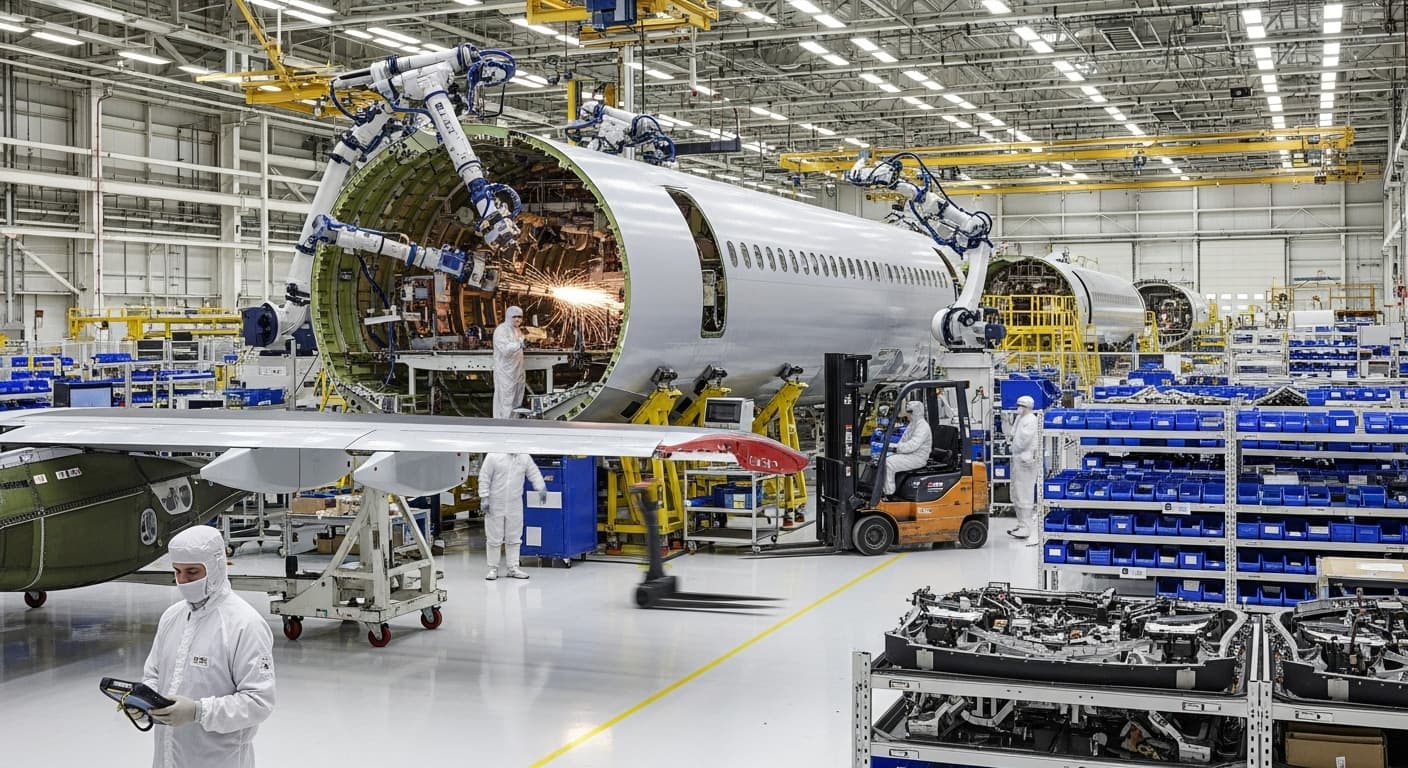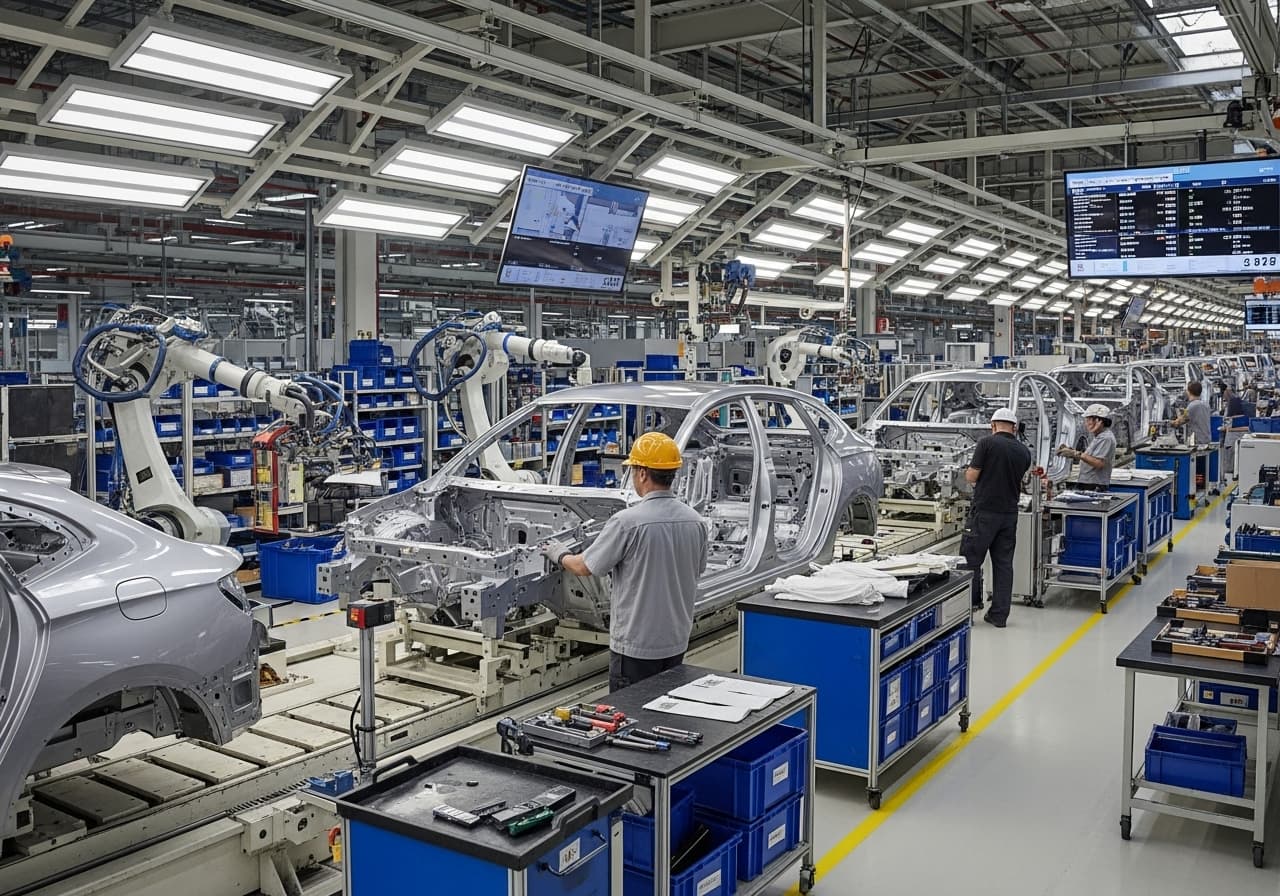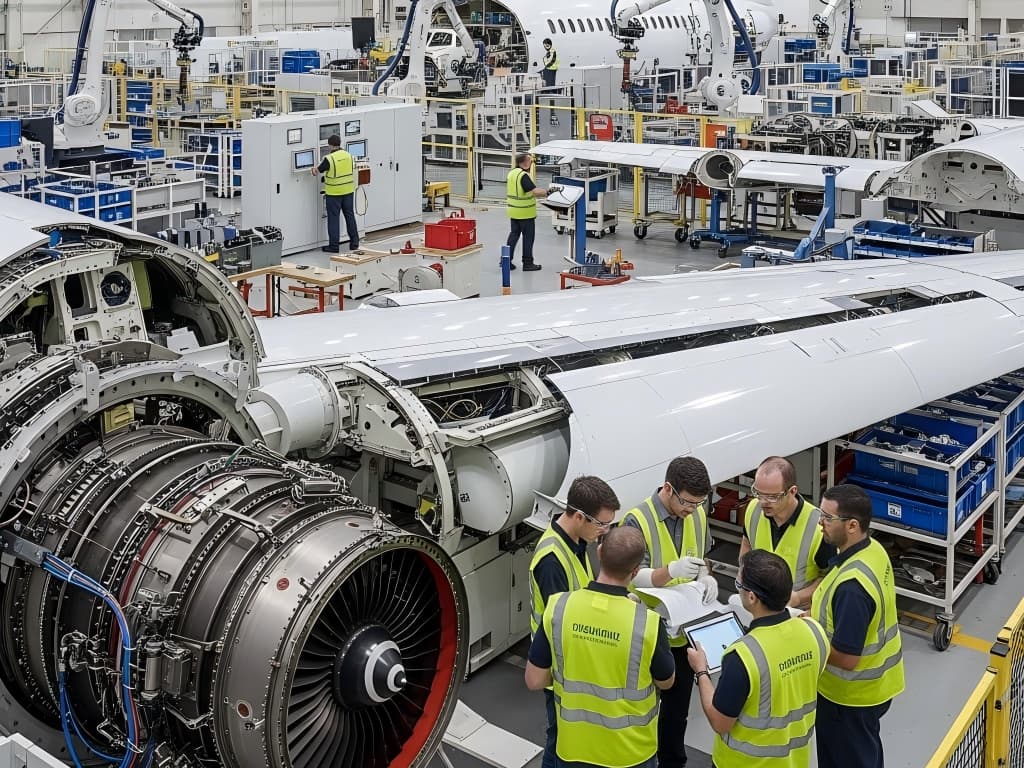Aerospace Manufacturing
The Definitive Guide to Aerospace Manufacturing
From a single critical fastener on a landing gear to the complex turbine blades of a jet engine, aerospace manufacturing is a discipline where there is zero room for error. Every component must perform flawlessly under extreme stress and temperatures, where failure is not an option.
This guide was created to be the most comprehensive resource for the engineers, procurement managers, and designers at the heart of this demanding industry. Here, you will find expert insights into the advanced materials, precision processes, and stringent quality standards that define modern aerospace, empowering you to navigate its complexities with confidence.

What is Aerospace Manufacturing? The Pursuit of Perfection
Aerospace manufacturing is the specialized discipline of building components for aircraft, satellites, and spacecraft, where absolute perfection is the only acceptable standard. Unlike mass-production industries that prioritize cost, aerospace is singularly focused on safety and reliability in extreme environments. This relentless pursuit has driven the industry's evolution from early aluminum alloys to the advanced composites and 3D-printed superalloys used in modern space exploration. This entire field is built upon three foundational pillars:
- Precision: Achieving exact tolerances to ensure parts function perfectly under immense stress.
- Our Material Selection: Employing high-performance alloys and composites to achieve optimal strength-to-weight characteristics and durability in harsh environments.
- Certification: Following strict, traceable quality standards like ISO 9001 to prove every component is airworthy.
Core Aerospace Manufacturing Processes: From Concept to Component
Transforming aerospace designs into ready-to-use components requires a complex array of manufacturing processes. Each solution is selected based on its unique ability to meet specific performance, material, and certification requirements. Below are the core technologies that form the backbone of modern aerospace production, from basic machining to innovative prototyping that accelerates development.
- Subtractive Manufacturing: Precision CNC Machining for Aerospace
Precision CNC machining remains the backbone of aerospace manufacturing, relied upon for creating the most critical, load-bearing components. This subtractive process carves complex parts from solid blocks of high-strength materials like titanium and aluminum. Using advanced 5-axis CNC machining, we produce intricate geometries like turbine blisks and impellers with a single setup, ensuring perfect accuracy. For rotational aerospace components, CNC turning delivers perfectly concentric shafts, valves, and fittings. The ultimate goal is achieving the tight tolerances, often measured in microns, required for flawless integration and performance under extreme stress.
See Our Precision CNC Machining Capabilities
- Formative Manufacturing: Advanced Sheet Metal Fabrication for Aircraft
The skin and structural framework of an aircraft are built using advanced sheet metal fabrication. Processes like precision laser cutting, CNC bending, and hydroforming shape high-strength aluminum and titanium sheets into durable yet lightweight airframe components, brackets, and avionics enclosures. The focus is always on maximizing the strength-to-weight ratio, a critical factor in aircraft performance and fuel efficiency. Every bend and joint is engineered for structural integrity, forming the very skeleton of modern aircraft.
Explore Our Sheet Metal Fabrication Services
- Prototyping & Replication: Accelerating Aerospace Innovation
Before full-scale production, designs must be rigorously tested and validated. This is where prototyping and replication accelerate innovation and de-risk investment:
- Rapid Prototyping: Our rapid prototyping services provide engineers with physical models for critical design validation. These prototypes are used for fit-checks, aerodynamic analysis in wind tunnels, and functional testing, allowing teams to iterate designs quickly before committing to expensive production tooling.
- Vacuum Casting: For low-volume production of high-fidelity plastic parts, vacuum casting (or urethane casting) is the ideal solution. It allows us to create components like interior bezels, ductwork, and electronic housings using materials that accurately simulate the properties of final injection-molded parts.
Discover Our Prototyping & Casting Solutions
Aerospace-Grade Materials: The Science of Strength and Weight
In aerospace engineering, success is measured by the critical balance between strength and weight. Every component, from a simple bracket to a turbine blade, must deliver maximum performance with minimal mass. This relentless pursuit of efficiency drives material innovation. Understanding the distinct properties of these advanced materials is not just an academic exercise—it's fundamental to manufacturing parts that meet the punishing demands of flight. Here, we explore the core materials your projects rely on, demonstrating our deep expertise in machining them to perfection.
High-Performance Metal Alloys
Metal alloys remain the backbone of aircraft construction, engineered to provide predictable strength and reliability. The key is choosing the right alloy for the right application.
- Titanium Alloys: Renowned for their exceptional strength-to-weight ratio and outstanding corrosion resistance, titanium alloys like Ti-6Al-4V are critical for high-stress applications. We machine them for structural airframe components, landing gear assemblies, and mission-critical engine parts where performance cannot be compromised.
- Aluminum Alloys: Valued for their low density, excellent machinability, and cost-effectiveness, aluminum alloys are ubiquitous in aviation. From fuselage skins and stringers to complex milled-from-billet interior components, their versatility makes them a manufacturing staple.
- Stainless Steel: When sheer strength, heat resistance, and durability are paramount, stainless steel is the material of choice. While heavier, it is indispensable for high-wear components, hydraulic fittings, and engine exhaust systems that must endure extreme conditions.
Superalloys for Extreme Environments
When temperatures soar beyond the limits of conventional metals, superalloys take over. Materials like Inconel and other nickel-based alloys are engineered to thrive in the most hostile environments within an aircraft. Their defining characteristic is the ability to maintain exceptional mechanical strength, surface stability, and creep resistance at extreme temperatures. This makes them essential for the hottest sections of jet engines, including combustion chambers, turbine blades, and exhaust nozzles, where component failure is not an option.
Advanced Composites and Plastics
The future of aerospace is increasingly lightweight. While the fabrication of carbon fiber composites is a specialized field, the post-cure precision machining of these structures is a critical step we often handle. However, for many applications, high-performance polymers offer a revolutionary, machinable alternative.
We focus on materials like PEEK (Polyether Ether Ketone) and ULTEM (Polyetherimide), which bridge the gap between plastics and metals. These polymers provide:
- Significant weight savings over aluminum.
- Excellent thermal stability and chemical resistance.
- Impressive strength and stiffness for their density.
The Non-Negotiables: Quality, Standards, and Compliance
In aerospace, quality isn't a feature—it's the bedrock of safety and performance. Our entire operation is built on a foundation of verifiable quality, rigorous standards, and unwavering compliance. For our partners, this means reduced risk, stable supply chains, and complete confidence in every part we deliver.
- ISO 9001 Certified with a Rigorous Aerospace QMS
- Proof of Precision: CMM & First Article Inspection (FAI)
- Defense & Security Compliance: ITAR and DFARS Ready
Why Choose Protofirster for Your Project Needs?
Our Advantages:
- Fast Turnaround: 2 working days for urgent cases.
- MOQ 1pc: Feasible for prototype and low volume to meet your requirements at any stage.
- High Precision: General tolerance is ±0.01mm; the best we can do is ±0.025mm.
- Engineer Support: Our experienced engineer can help provide DFM to improve your design and save on the budget.
- One-stop service to achieve centralization and efficiency of the supply chain.
Start your free project evaluation and experience:
- Your dedicated service consultant - tailor-made services.
- Easy to understand and communicate with us in a language you understand.
- Excellent quality and peace of mind - Expected results, guaranteed quality.
- All CAD files are secure and confidential.
Your next aerospace project demands more than just manufacturing. It demands a partner committed to absolute precision, unwavering quality, and mission-critical reliability. Have a drawing or CAD file? Send it now, get an Instant Quote. Or need to discuss material selection, DFM, or a complex technical challenge? Speak with an Aerospace Engineer.
 Medical Device Prototyping
Medical Device Prototyping
 Automotive Parts Manufacturing
Automotive Parts Manufacturing
 Aerospace Manufacturing
Aerospace Manufacturing
![[Guide Updated] Please See Our New Low Volume CNC Machining Page](/uploads/20250809/e0980b58d9f1528680f9fe34ae16af14.png) [Guide Updated] Please See Our New Low Volume CNC Machining Page
[Guide Updated] Please See Our New Low Volume CNC Machining Page

